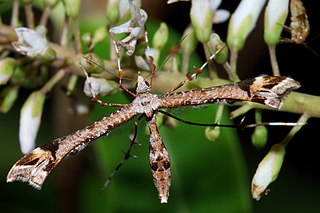
Amblyptilia falcatalis, the common Hebe plume moth, is a species of moth of the family Pterophoridae. This species was first described by Francis Walker and is endemic to New Zealand. This species can be found in both the North and South Islands. The larval host plants are in the Veronica genus and include Veronica stricta,Veronica salicifolia,Veronica elliptica, Veronica macrocarpa and Veronica speciosa. This moth likely has two broods a year and adults have been observed all year round.

Izatha attactella is a moth of the family Oecophoridae. This species is endemic to New Zealand, where it is known from both the North and South Islands as far south as mid-Canterbury. Larvae of this species feed on the soft inner surface of the bark of dead trees and shrubs. Adults have been recorded from September to December.
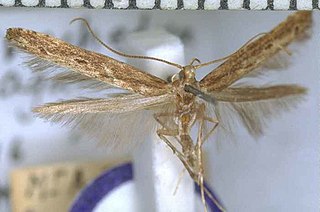
Batrachedra agaura is a species of moth in the family Batrachedridae. It is endemic to New Zealand. This species is distributed throughout the country. The species inhabits native forests, especially beech and kanuka forests or manuka scrubland. The larvae of this species are associated with sooty mold and sooty beech scale. It has been hypothesized that the larvae feed on sooty beech scale. However, they may also feed on the sooty mold itself. The adult female is lighter in appearance than the male, and the species shows considerable variation in patterns on the forewing. Adults are on the wing from October to February. They are nocturnal and occasionally attracted to light.
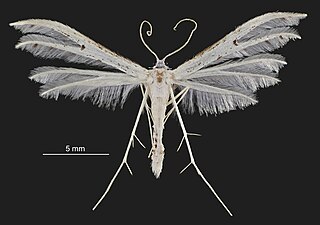
Pterophorus monospilalis, the white plume moth, is a moth of the family Pterophoridae. It is endemic to New Zealand and occurs throughout the country. It inhabits native forest, parks and domestic gardens. Larvae are active during the day, are slow moving, and feed exposed. They feed on Araliaceae species as well as on Hedera helix, Meryta sinclairii, and Schefflera digitata. There are several broods in a year. Adult moths are on the wing from November until May and are attracted to light.
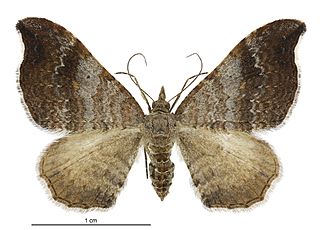
Homodotis megaspilata, also known as the small hooked-tip looper moth, is a moth of the family Geometridae. It is endemic to New Zealand and can be found throughout the country. It is regarded as being common species. The preferred habitat of this species is native forest, scrub, coastal areas and domestic gardens. Larvae feed on the dead leaves of Geniostoma ligustrifolium and likely other native plants. Once mature the larvae will pupate on the ground forming a silken cocoon protected by hiding inside two leaves of its host plant. Adults are nocturnal and are on the wing from October to April. They are attracted to light. In appearance the adults of this species are extremely variable but can be distinguished from similar species as all variations have forewings with blunt hook shaped tips.

Reductoderces araneosa is a moth of the family Psychidae. It was described by Edward Meyrick in 1914. It is endemic to New Zealand and can be found in the lower part of the South Island. The preferred habitat of R. araneosa is on the edge of native beech forest. The larvae construct a case made from silk, moss and lichens and emerge from it to feed. The female of this species is wingless. The males of this species are on the wing in November and February and have been captured in the early morning.

Hierodoris illita is a moth of the family Oecophoridae. It is endemic to New Zealand and is found in both the North and South Islands. However this species has not been recorded at Stewart Island / Rakiura.

Glaucocharis elaina is a species of moth in the family Crambidae. This species was described by Edward Meyrick in 1882. It is endemic to New Zealand and is found throughout the North and South Island with the exception of the extreme south of the South Island. The preferred habitat of this species is lowland native forest and as adults the species is attracted to broken ground including road or rail cuttings. Larvae feed on moss species including those in the genus Funaria. This species has two distinct broods during each year. Adults are on the wing from October to April, are nocturnal and are attracted to light.
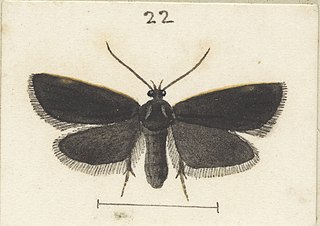
Cryptolechia semnodes is a moth in the family Depressariidae. It is endemic to New Zealand. It was first described by Edward Meyrick in 1911 using a specimen collected at Mount Arthur tableland in February. It is dark in appearance and likely belongs to another genus. This species flies in bright sunshine and is likely a very local species. It is likely that this species probably belongs to another genus and as such this species is also known as Cryptolechia (s.l.) semnodes.

Proteodes carnifex is a species of moth in the family Depressariidae. It is endemic to New Zealand. Both the larvae and the adults of this species are variable in appearance. However the adults are normally easily identified as the outline is characteristic and the size is consistent. In appearance, adult moths mimic the leaves of their larval host plants. This species has been found near Wellington in the North Island, the tableland of Mount Arthur, in the Canterbury region, Arthur's Pass and at Lake Wakatipu in the South Island. The larval hosts of this species are southern beech trees, particularly black beech and mountain beech but larvae have also been found on Nothofagus fusca, Nothofagus truncata and Nothofagus menziesii. The female moth deposits her eggs individually on the underside of native beech tree leaves. Once hatched the larvae feed on those leaves through winter and spring and then pupate in January. The adult moth emerges from the pupa after fourteen days and is on the wing from January until April. They are day flying moths and are not attracted to light. Various insects parasitise the larvae of this moth including several species of wasp as well as flies including the endemic fly, Pales funesta.

Tingena chloritis is a species of moth in the family Oecophoridae. It is endemic to New Zealand and has been found in the South Island. Larvae of this species feed on leaf litter. The adults of this species are light flyers and are attracted to light.

Tingena hoplodesma is a species of moth in the family Oecophoridae. It is endemic to New Zealand and has been found in the North and South Islands. T. hoplodesma prefers native beech forest habitat and adults are on the wing from January to March.
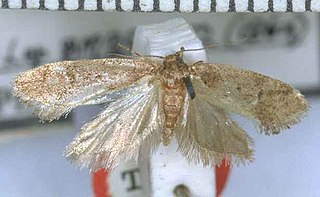
Tingena innotella is a species of moth in the family Oecophoridae. It is endemic to New Zealand and is found in both the North and South Islands. This species inhabits open native forest or scrubland and adults are on the wing from December to March. T. innotella appears to have an affinity for the silver tree fern.

Tingena oxyina is a species of moth in the family Oecophoridae. It is endemic to New Zealand and has been observed in the Otago region. This species inhabits native beech forest at altitudes of between 1000 - 3000 ft. Adults of this species are on the wing in January.
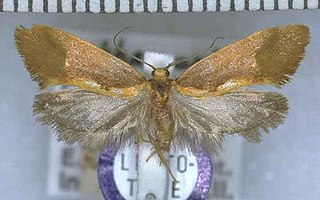
Tingena phegophylla is a species of moth in the family Oecophoridae. It is endemic to New Zealand and has been observed in the southern parts of the South Island. This species inhabits native beech forest. The adults of this species are on the wing in December.

Trachypepla contritella, the Kiwi Enigma, is a species of moth in the family Oecophoridae. Originally endemic to New Zealand this species can be found throughout that country. However, from 2012 this species has been also been recorded in the United Kingdom. The preferred habitat of T. conritella is New Zealand native forest and larvae of this species are litter leaf feeders. Adults are on the wing from November to February in New Zealand and are attracted to light.
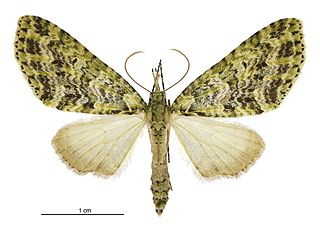
Tatosoma tipulata, also known as the kāmahi green spindle, is a species of moth in the family Geometridae. It was first described by Francis Walker in 1862. It is endemic to New Zealand and occurs in the North, South and Stewart Islands. This species inhabits native bush. The larvae have been recorded as feeding on Pterophylla racemosa, Nothofagus cliffortioides and Podocarpus totara. Adult moths are most commonly observed on the wing from September until March. Adults are nocturnal and are slightly attracted to light. They have also been collected via sugar traps. During the day adults can often be observed resting, camouflaged against moss and lichens, on the trunks of trees.

Atomotricha isogama is a moth in the family Oecophoridae. It was first described by Edward Meyrick in 1909. This species is endemic to New Zealand and has been observed in the North and South Islands. Larvae are leaf litter feeders and have been recorded as emerging in the New Zealand spring. Adults have been observed on the wing from July to January.
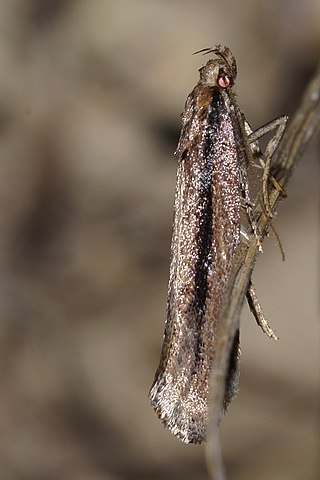
Atomotricha versuta is a moth in the family Oecophoridae first described by Edward Meyrick in 1914. It is endemic to New Zealand and has been observed in both the North and South Islands. The adults of the species are variable in appearance but the three principal variteis are connected b intermediate forms. The female of the species is brachypterous and is incapable of flight. Both the adult male and female have been observed resting on fences during cold winter nights.

Trachypepla lichenodes is a moth of the family Oecophoridae first described by Edward Meyrick in 1883. It is endemic to New Zealand and has been found in both the North and South Islands. It inhabits native forest and adults of this species are on the wing from November to January. The adult moths are similarly coloured to native lichen species however this colouration is variable in the extent and depth on the forewings.






















